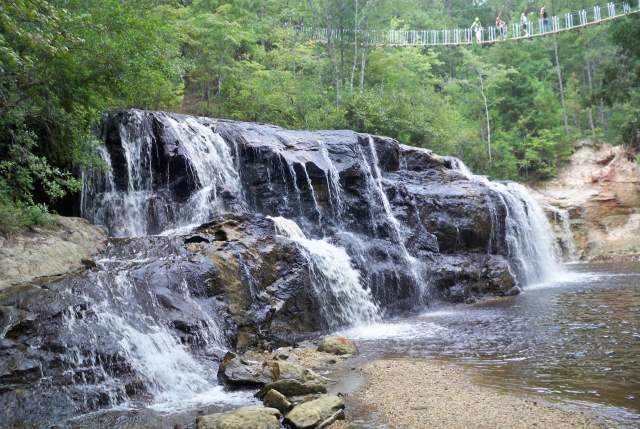How well do you know Cumberland County, NC and its history? Since Fayetteville predates the Revolutionary War, this area's history is steeped with people and places that have left their mark on our community, the nation, and even the world. When I saw NC Tripping share "50+ Facts about North Carolina That You Should Know, But Probably Don't" recently, I wondered if I could come up with an equally impressive list of facts about our part of this great state. I've compiled a list of some facts that might come as a surprise to non-residents (and maybe even residents), and I'd challenge you to test your own knowledge of Cumberland County!

1. One of the nation’s first well known African-American novelists, Charles W. Chesnutt, grew up in Fayetteville, and from 1880 to 1883, he served as principal of The State Colored Normal School, which later evolved into our HBCU, Fayetteville State University.
2. Until the summer of 2016, the largest catfish ever caught in the state of North Carolina had been hauled in from the Cape Fear River in Fayetteville, and it weighed in at 78 pounds and measured 52 inches long.
3. The Fayetteville Independent Light Infantry (FILI) was formed in 1793 under the Militia Act, was signed by George Washington, and is the oldest military unit in continuous existence in the South today, acting as North Carolina’s Official Historic Military Command.
4. Long Valley Farm, the winter estate of James Stillman Rockefeller (of Rockefeller fame), is located at Carvers Creek State Park in the Town of Spring Lake, and when the park is open, rangers lead free tours of the Rockefeller House and farm structures a few times each month.
5. George Herman “Babe” Ruth hit his first home run as a professional baseball player in Fayetteville during 1914 spring training with the Baltimore Orioles and earned his nickname while staying here.

6. Cumberland County’s first brewery, Huske Hardware House Restaurant & Brewery, opened its doors in downtown Fayetteville in 1996. The building that houses this brewery was built in 1903 by Benjamin R. Huske and served as a hardware store for 67 years. Having been restored, Huske retains much of its early 20th-century charm, to include its Victorian-era masonry frame, and is listed in the National Register of Historic Places.
7. Fayetteville native and Union Army veteran Hiram Revels became the nation’s first African-American U.S. senator in 1870, serving in the Mississippi State Senate, before moving on to become president of an HBCU.
8. The community boasts one of the “Top 10 Ziplines in the U.S.,” according to USA Today—ZipQuest Waterfall and Treetop Adventure—where you can also zip across one of the largest waterfalls in the Eastern Carolinas, Carvers Falls.
9. Fort Bragg is the largest U.S. Army installation in the world in terms of population, as it is home to over 45,000 active-duty service members, and land wise, it spreads out over 163,000 acres across four North Carolina counties.
10. One of Cumberland County’s oldest and largest municipalities, the Town of Hope Mills, can trace its first permanent settlement back to 1789, after a large sawmill had been built along Little Rockfish Creek. By the 1840's, this settlement’s Rockfish Factory was the largest cotton mill in the state of North Carolina (later one of eight cotton mills in Cumberland County to be burned down by General Sherman’s troops). Today, this town celebrates its history with “Ole Mill Days,” an annual festival that pays homage to its origins.

11. During his 1825 tour of the U.S., “Americas Favorite Fighting Frenchman”–the Marquis de Lafayette—made his way south to visit Fayetteville, the only namesake city he visited during his stay. Fayetteville celebrates this history each year, in September, with the Lafayette Birthday Celebration.
12. Leah Hiebert, wife of a deputy post chaplain, was the artist who sculpted in 1961 what would become perhaps Fayetteville’s most significant icon—the Airborne Trooper Statue, more commonly known as “Iron Mike." This 3,235-pound, 16-foot-tall, steel figure stands in front of our Airborne & Special Operations Museum today as “a symbol to freedom-seeking peoples throughout the world.”
13. ParacleteXP Indoor Skydiving offers an opportunity to experience skydiving in the U.S.’s largest vertical wind tunnel, where the world-famous Golden Knights train.
14. After having polled their Facebook followers on the best pies (and pie shops) in America, Tasting Table declared, “no flag waved as freely as the one for this veteran-owned-and-operated shop”—our very own Fayetteville Pie Company.
15. African-American residents of our Town of Spring Lake built the Spring Lake Civic Center, now known as the Sandhills Family Heritage Center, in 1945 to serve as an event venue for social and community events. At no time was that more needed than during the Civil Rights era, when the Civic Center served as a safe place for African Americans to hold voter-registration drives, work on school desegregation efforts, host NAACP meetings, and more.

16. Before his NBA career launched with the Dallas Mavericks and then the New York Knicks, Fayetteville native Dennis Smith, Jr. led his alma mater, Trinity High School, to a state championship, was considered one of the nation’s top point guards in the high school class of 2016, and was named ACC Freshman of the Year after playing one semester for North Carolina State’s Wolfpack.
17. Cool Spring Tavern is believed to be Fayetteville’s oldest existing structure, having been built in 1788 and survived the city’s “Great Fire of 1831,” and it is listed in the U.S. National Register of Historic Places. During its heyday, this tavern housed some influential people—to include state delegates, who ratified the U.S. Constitution here in 1789, and the American novelist Carson McCullers, who wrote part of her first novel, The Heart Is a Lonely Hunter, during her stay in the tavern.
18. Cumberland County’s Long Leaf Pine ecosystem is home to endangered species, including the Red Cockaded Woodpecker, and Fort Bragg has won several environmental awards for its natural resources conservation efforts, in part because of its protection of that woodpecker. Our Fayetteville Woodpeckers MiLB team name is an homage to this fierce little bird.
19. Olympic athlete Jim Thorpe played professional baseball for the Fayetteville Highlanders, starting mid-season in 1910, and one of the lengthy home runs he hit here is still part of local lore.
20. Our Airborne & Special Operations Museum (ASOM) is also home to the SOF (Special Operations Forces) K9 Memorial, the only one of its kind, where canine handlers are able to honor and memorialize those dogs that died while serving in combat operations with the United States, United Kingdom, and Australian SOF. Each Memorial Day, the ASOM holds a special wreath-laying ceremony just for these heroes, and they also list their names and service record on their website.

21. The Old Bluff Presbyterian Church, founded in 1758, is one of the oldest churches in Cumberland County. Scot Highlander settlers in the area continued to conduct services in Gaelic there for almost 100 years, and visitors will find several of their memorials and graves in the adjacent cemetery. In 1853, this congregation built their third sanctuary, a Greek Revival structure, in what is now known as the Town of Godwin, and it is listed in the National Register of Historic Places.
22. Isaac Hammond became the first fifer to serve in our Fayetteville Independent Light Infantry (F.I.L.I.), and this African-American soldier went on to serve in the Revolutionary War. A memorial known as “Fifer's Grave” stands on our F.I.L.I. Parade Grounds, off North Cool Spring Street, to honor this patriot’s 30 years of service for our country.
23. The Pentecostal Holiness Church (PHC), now known as the International Pentecostal Holiness Church, can trace its origins back to the Falcon Tabernacle (also known as the "Octagonal Tabernacle") in our Town of Falcon, where two denominations officially merged to form the PHC in 1911. That historic, octagonal tabernacle was constructed in 1898 with wood from trees that had been uprooted by a tornado, and today, it still stands and is listed in the National Register of Historic Places.
24. Judith Cage, better known as “Chef Judy,” is an Army veteran and local caterer/restaurateur who owns several Southern-style eateries around Cumberland County, to include Let Me Cater to You and Uptown's Chicken & Waffles. Chef Judy has appeared on four different Food Network shows, bringing home a win from her last appearance in 2019.
25. Cumberland County is home to North Carolina’s only dedicated fishing education center, the John E. Pechmann Fishing Education Center. Operated by the North Carolina Wildlife Resources Commission, the center’s mission is to educate the public on aquatic habitat conservation, and they accomplish that by offering a wide range of interactive programs and clinics, to include free public fishing events.
Want to learn more about Cumberland County's rich history and modern-day offerings? Our Cultural Heritage Trails are a compilation of 17 themed driving trails that feature the many people and places that have formed America's Hometown. Take a deep dive into The Historic Architecture Trail, discover culinary delights on The International Cuisine Trail, explore some outdoor gems on The Fish & Game Trail, and learn why this truly is such a special place.
